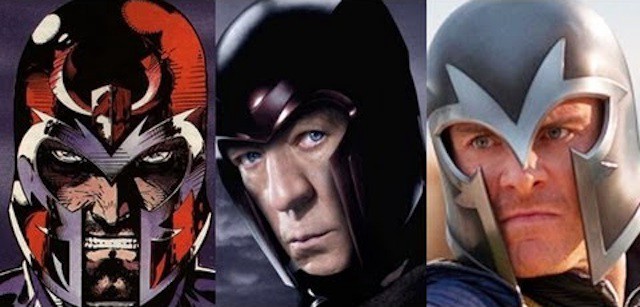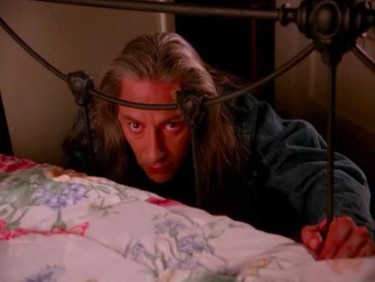Magneto, the Mighty Jew

If you saw any of the X-Men movies, was there any doubt that Erik Lensherr — the young man who goes all Uri Geller when the Nazis put his parents in Auschwitz — is a Jew? Followers of the 50-year-old X-Men comic books have different opinions. Some say “Magneto” (or Magnus or Erik, whatever you like to call him) is actually of Romany blood. (Nazis, you may recall, also massacred Gypsies, homosexuals, Communists, Poles, Czechs, Russians, Ukrainians and Freemasons.) But in the form of actors Ian McKellen and Michael Fassbender, Magneto has a concentration-camp tattoo identifying him as Jewish. Does this matter? Aren’t most comic-book heroes also of the Chosen People? Of course it matters! Magneto is very powerful and a good chess player. But why put such a terrible real-world thing in a comic book?
So let’s have a look at Magneto’s real progenitors, and by that I mean folks on our side of the border: Kirby, Lee and Claremont. Kirby and Lee, like the vast majority of comic book pioneers, were Jews of Central European origin. It’s unlikely they would let a word like Auschwitz get into one of their publications without a lot of thought. As for Claremont, who developed the psychology and history of Magnus so brilliantly, he’s known for the seriousness and wholehearted care he puts in his work. If he wrote Auschwitz, he meant Auschwitz.
One reader of this piece noted that his non-comic-book-reading wife watched X-Men: First Class and assumed throughout the movie that Magneto was the hero. It’s sort of true, too. And both McKellen and Fassbender will be back as Magneto (some kind of time-travel story, apparently) in the new X-Men movie, which Bryan Singer has come back to direct, hooray.
Man Hates Self, Twitter
“It’s hard to pinpoint the exact moment it happened — but at some point, Twitter became a dark place.” lol LOL
— Shani O. Hilton (@shani_o) January 30, 2013
One Matt K. Lewis is very angry with Twitter.
But first, I’m in love with his opening sentence. “Soren Dayton and Rob Bluey — two conservative tech geniuses — talked me into joining Twitter during a lunch Ed Morrissey organized at an Iraqi restaurant in Minneapolis during the 2008 Republican convention.” I’ve heard of maybe two of these things, if you include “2008.” WHY. WHAT? But in any event, here’s the story of what happened to Matt K. Lewis: Twitter went evil all around him.
“It’s hard to pinpoint the exact moment it happened — but at some point, Twitter became a dark place. It’s a lot like the transformation of the 1960s. It started out being about free love, sharing ideas, and changing the world, but somehow we ended up being more about Altamont and Charles Manson.”
I mean personally I would compare what happened to Twitter to Kent State, but okay. (Too soon?) It is meaner now, he thinks, and “coarser.” Most interesting about this take is that it’s in direct contradiction to the idea of “the new niceness.” It’s also a bit odd coming in the week of the debut of Vine, where the comment prompt, amazingly, is “say something nice.” (Also I do not think Twitter started out as anything to do with “changing the world.)
Whenever someone writes one of these screeds, they have to ignore that Twitter is entirely self-selecting. You chose who to follow. You chose to behave like a jerk, or a needy child, or a boor. Twitter didn’t make you an ass. Twitter gave you an opportunity to exhibit your lack of impulse control. (It seems fair to mention here that I have learned a few hard lessons about my own bad behavior, lack of impulse control and inability to manage tone on the Internet on Twitter. Fortunately I’m an adult and have learned from some of my mistakes. SOME, I said.) Twitter gave us all a chance to prove to again that sometimes we have no boundaries. So if you can’t simply unfollow people you don’t care about, or block people that gross you out, you need to go back to therapy. Twitter is almost entirely a projected fantasy life of people you think or wish were your friends and your society. I say “almost” because, if you’ve ever been harassed or stalked online, lemme tell you, it’s both terrible and not your fault. But otherwise? Most everything that you consume on Twitter is because you chose it. And if you can’t live with what you’ve made for yourself, you should definitely make like Matt K. Lewis and leave. Then you’ll be safe. Until you publish a piece about it. And everyone makes fun of you on Twitter. Which seems kind of unfair, really, but here we are.
Alcohol Improves World's Most Boring "Sport"
The Wall Street Journal had to send someone all the way to Minnesota to report out the story that fishing is only tolerable when you’re drunk.
I Want To Know What's Wrong With Being An Internet Troll
by Henry Blodget

From time to time, The Awl offers its space to everyday citizens with something to say.
In light of a recent gripping narrative I wrote about air travel I have been hearing a lot of complaints about “internet trolling.”
“Henry only wrote this to get attention,” some people said. “This is a new low, even for Henry,” Twitter users complained. “How does this dumb fuck even breathe properly, let alone dress himself in the morning,” asked all three members of the Council of Economic Advisers.
And so on.
But I have an interesting and important question.
(To me, all questions are interesting and important. As are all experiences! I took a cab ride the other day where the guy went up Sixth instead of Madison and I think it was just so he could charge me more! As soon as we finish assembling the slide show you can read all about it.)
What is the problem with Internet trolls? Why do people dislike them so much? Is it just an example of following-the-herd mentality? Some kind of deeper prejudice? A love of bridges?
What is the source of this animosity? Why does it perpetuate itself? Where did this prejudice come from?
What is wrong with writing something deliberately inflammatory, or even hysterically obtuse, just so enough people will pass it around that it goes “viral” on the “Internet”?
Look, I’m not stupid. I know that when I die the first line in my obituary is going to include the phrases “securities fraud” and “banned for life.” It would not be inaccurate to call me the poster boy for the kind of insider dealing and duplicity that made Americans realize just how rigged the game is against them. In fact, you could say that I’m the guy who caused the financial crisis and all the suffering we are still going through five years later. Sure, it would be overblown and largely inaccurate, needlessly overdramatizing a minor issue just to get attention and maybe make a point, but still, you could say it. I mean, yes, the fact that I have been able to move on to my current career, and to do quite well from it, is a testament to the total decline in the traditional concepts of personal responsibility and moral behavior to which the men of every preceding generation in this country had to adhere if they wanted to consider themselves decent human beings. Thirty years ago someone found culpable of the kinds of gross fraud and deceit I perpetrated would have thrown themselves out a window or gassed themselves in a garage, and while people would have shook their heads and muttered a few things about how awful suicide is, deep down they would have thought, “Well, good for him; at least in the end he did the only right and honorable thing he could have done.” But today, so long as you have a total lack of shame about your actions, not only can you survive the justified opprobrium of society, you can do quite well from it. It’s weirdly freeing: Once you realize that, for the rest of your life, everyone is going to point fingers at you in the public square and hiss, “Scumbag,” having them also think you’re an idiot is a small price to pay, particularly if you can monetize that imbecility. Is there a sweeter revenge than coming to the point where your personage is so tarnished that even you stop caring what people think of you? Once you get past the very real truth that everyone thinks you’re a vile, disgusting human being you can let yourself do almost anything without worrying that people will laugh at you. So what if they laugh? More money for me! Admit it, you even occasionally entertain a grudging admiration for my talents. Some days you find yourself envious of my ability to go about life with a complete disregard for the utter lack of esteem every even marginally respectable person in the world holds for me.
Anyway, what was I saying? Oh, right, so I honestly can’t understand what is the problem is with trolling, and I don’t know why anyone won’t tell me. I guess it will always be a mystery, like why [deaf people talk funny/women suck so bad at math and science/you can’t trust a Greek guy around sheep — check what’s trending and pick one]. It just seems weird that I’m the only one who is willing to talk about it.
Henry Blodget is the CEO and Editor-in-Chief of The Business Insider, a leading online business publication.
UPDATE: Henry Blodget asked us to make clear that this is a piece of parody which he did not himself write.
SIGH, RELATED: Why I Am Leaving the Muppets, by M.B. Cluckerton
I Enjoy Being A Lesbian, by A Lesbian Blogger
Why Won’t You Simply Let People Despise Jews?, by Maria Theresa Walburga Amalia Christina
Fine, I’ll Talk, by Harper Lee
The Way We 'Times' Correction Now
“A picture caption on Friday with an article about putting aside technology and to-do lists and exploring New York City misidentified the ‘arugula-loving’ vehicle shown in Brooklyn. It is a Land Rover, not a ‘jeep.’”
America's Next Top Dance Chef Band
The Trisha Brown retirement fiesta begins at BAM, Eddie Huang’s book tour begins, and Titus Andronicus plays at the Brooklyn Bowl. I wish all of these things were happening at one event. How much do people love Titus Andronicus? So much. Anyway, there’s even much more.
The Terror Of "Twin Peaks": His Name Is BOB
by Matthew J.X. Malady

Myriad outrageous things occurred during the two seasons of “Twin Peaks” that aired on ABC in the early 1990s. A fish somehow got stuck in a coffee percolator, a sheriff’s deputy knocked himself silly by stepping on a loose board, Sherilyn Fenn tied a cherry stem into a knot with her tongue. Verbal tics and regional dialects and odd vocal registers predominated. Dwarfs and doppelgangers spoke backwards. David Duchovny showed up wearing a dress. Many of these things came off as humorous, and each episode provided at least five or six chuckle-worthy moments — which, as offsets go, is only fair, considering that the David Lynch and Mark Frost–created television program also offered up one of the scariest, most terrifying, most nightmare-inducing-est characters ever to appear on the small screen: BOB.
This essay is part of a series about our favorite TV shows past.
Previously: What Made “The O.C.” Great, Bitch
Why delay the terror? Here’s a scene from season two of “Twin Peaks” in which BOB, played by Frank Silva, enters the frame from the right, creeps into a living room, and crawls over a sofa. Warning: Don’t watch it at night, or while spending time at a cabin in the woods, or alone, or if you have some sort of important meeting or interview in the morning and need to get lots of sleep tonight. Actually, if you can, only watch this in a park or wide-open meadow somewhere, on a sunny day in the early summer, surrounded by hundreds of people playing Frisbee and rollerblading and flying kites. If you can get to the part of Alaska that experiences 24 hours of sunlight each day for 12 weeks in the summer, do that. And, in any case, if someone just happens to be blasting Skee-Lo’s “I wish I was a little bit taller,” or “Shiny Happy People,” or some other goofball jam while you watch, all the better.
So, yeah, that’s BOB. Let me not get ahead of myself here, though. Some refresher points if your memory of the show has dimmed [if, by chance, you have not yet watched “Twin Peaks” — the TV show, not the movie… which came after the show and is related, but different — and had been meaning to do so someday, stop reading at this point to avoid spoilers and then devote the entire upcoming weekend to a Netflix-streamed “Twin Peaks” marathon]: “Twin Peaks” chronicled the efforts of FBI Special Agent Dale Cooper, played by Kyle MacLachlan, in attempting to determine who murdered Laura Palmer, a cherub-faced and immensely popular high school student with an overflowing goodie bag full of dark secrets. Cooper is aided in his sleuthing by members of the local Twin Peaks police force: Sherriff Harry S. Truman; the stoic and wise Native American deputy, Hawk; and a Pee-wee-Herman-meets-Ernest-Goes-to-Camp deputy named Andy. Those three are relatively normal as compared to so many other Twin Peaks residents, and, as a result, red herrings crop up everywhere during the show: “Why does that lady talk to a log?” “What’s with that other woman’s eye patch?” “Does the fact that those two guys in the jail started barking like dogs for no apparent reason mean something?”
The first insinuation of BOB occurs in the series pilot, when Agent Cooper digs deep below the recently murdered Laura Palmer’s left ring fingernail with tweezers and — as we see in close-up detail — removes a tiny piece of paper with the letter “R” typed onto its surface. Later in the series, viewers find out the killer was spelling out ROBERT by leaving these letters on his victims’ bodies. (In a version of “Twin Peaks” for the European market that’s included in many DVD sets of the series, there is an alternative end section to the pilot that includes BOB. But that footage never appeared in the original American broadcast. Bits and pieces of the scene pop up in television episodes later as the series progresses.)
During the second non-pilot episode of season one, BOB receives a full and proper introduction in a dream sequence that materializes after Agent Cooper falls asleep. The scene is breathtakingly bizarre and completely unforgettable.
While a red-suited dwarf shivers, his back turned to the camera, viewers see assorted images interspersed between a strobe light effect, including BOB crouching down at the foot of Laura Palmer’s bed. A one-armed man named “Mike” reads a creepy poem in a super-creepy voice and then says: “We lived among the people. I think you say convenience store. We lived above it. I mean it like it is. Like it sounds. I, too, have been touched by the devilish one. A tattoo on the left shoulder. But when I saw the face of God, I was changed. I took the entire arm off. My name is Mike. His name is BOB.”
Cut to a shot of Silva, as BOB, standing in front of some detritus, bare-armed, and lit from the upper right. He snarls out: “Mike? Mike? Can you hear me? Catch you… with my death bag. You may think I’ve gone insane. But I promise, I will kill again.”
Thereafter, a vast array of additional peculiar things happen in the dream — people speak backwards, the dwarf talks about chewing gum and then dances around to a jazz tune — but by that point BOB had already stolen the show. And, in retrospect, you get the sense that Lynch and Frost fully realized this. BOB was visually non-existent and yet somehow completely omnipresent in each of the season’s five remaining episodes. After showing viewers his visage at the base of Laura Palmer’s bed and exposing them to that pronouncement about killing again, everything changed. Nearly every subsequent minute of the program was infused with an ominous, unnerving sense that BOB was near. Viewers could never fully relax — not even when Lynch’s hilarious Gordon Cole character was in the throes of talking way too loud, or when the only topic being discussed was the quality of one’s coffee — because BOB lurked somewhere beyond view, crouching, ready to pounce. And viewers who attempted to watch the show in a leisurely fashion did so at their own peril.
Girding one’s emotional state for the potential of BOB meant the “Twin Peaks” viewing experience was marked by a constant lack of comfort and security. In less than 40 seconds of total on-air time during season one, he had wedged and slithered himself into the amygdala of viewers’ brains, and the show’s writers and directors capitalized on that looming fear by producing a steady stream of non-BOB episodes.
***
Season two, though, it turns out, was all about BOB. In its first installment, one episode prior to the couch climb-over creepiness from above, viewers witnessed this gruesome BOB vs. Laura Palmer vision sequence from the bedside of Ronette Pulaski, another of the victims on the show:
[Author’s note: I am now writing with every light in the apartment turned on, full blast. Also: Huge props to my annoying upstairs neighbor, who, in a spectacular, perfectly timed, fear-relieving development, just started playing the acoustic guitar while singing Natalie Merchant and Sheryl Crow songs. I will never curse your stupid little yippy dog again, lady.]
And then, as with season one, there is another pause for effect. It takes an additional four non-BOB episodes before he appears again, but, this time around, his role in the Laura Palmer murder becomes apparent. As is the case with so much of what makes up “Twin Peaks,” the big reveal is steeped in duality. The answer to the question, “Who killed Laura Palmer?” is both facepalmingly simple and mind-numbingly complicated. Let’s start with the simple part: Her father, Leland Palmer, is the man who physically snuffed out Laura’s life. He is the killer. The father did it. But there’s more to it, of course. Watch what happens in the big reveal clip below wherein Leland murders Laura’s lookalike cousin, Maddy, in horrific, graphic fashion.
So now comes the more complicated stuff. The short version is that evil spirit BOB, who had gained spiritual possession of Leland Palmer when Laura’s father was a young boy, drove him to kill his daughter and several others. The longer version is so much more complicated and loopy, though. It goes at least somewhat like this:
When he’s not, you know, forcing host bodies to kill, BOB can sometimes be found at a place called the Black Lodge, a mysterious and ghastly realm with an entrance deep in the woods of Twin Peaks. In the TV show, the Black Lodge is associated with the vivid red, dwarf-inhabited, doppelganger-infested scarescape seen in Agent Cooper’s dreams and featured in the show’s final installment. During one second-season episode, Deputy Hawk explains the Black Lodge to Agent Copper by noting, “Every spirit must pass through there on the way to perfection. There you will meet your own shadow self. My people call it the ‘Dweller on the Threshold,’ but it is said if you confront the Black Lodge with imperfect courage, it will utterly annihilate your soul.”
Another character on the show, Cooper’s second-season nemesis Windom Earle, described the Black Lodge as: “A place of almost unimaginable power, chock-full of dark forces and vicious secrets. No prayers dare enter this frightful maw. The spirits there care not for good deeds or priestly invocations. They are as likely to rip the flesh from your bone as greet you with a happy ‘good day.’”
All this Black Lodge stuff coalesces in the series finale, with a truly epic and downright terrifying scene that finds Agent Cooper attempting to face down his fears in the lodge’s environs:
Thousands upon thousands — and perhaps even millions — of words have been written about what exactly might have gone on in that clip. Everyone has a theory. But rather than venturing down a wormhole into the realm of “Twin Peaks”–related Ph.D. theses and the like, I recommend putting the discoing dwarf and the doppelgangers to the side, and taking solace in the fact that not even David Lynch understands precisely what that scene represents. “Everyone wants to know what the Red Room in Twin Peaks stands for,” he reportedly told a German publication in 1992. “Even I don’t know what it exactly means. I can still remember well when I’ve had this idea but I don’t know why. … [T]he red curtains, the stylized design, the dancing dwarf. Even if I wanted to I wouldn’t be able to explain their meaning because intuition is irrational. The difference between reality and imagination wasn’t ever clear to me at all.”
The honesty and practical good sense at the heart of that admission is instructive — it represents a perspective that is perhaps best for everyone’s continued sanity, as well as for our capacity to function as socially proficient members of society. Toward that end, I strongly encourage the adoption of a theory of “Twin Peaks” relativism. Don’t warp your brain tying to untangle the vast, unknowable mysteries of the Black Lodge. Take a step back from the show’s hidden coconuts, and scorched oil smells, and ghost spirits trapped in dresser knobs, and instead simply consider the light-speed progression with which BOB advanced from unscripted accident, to a potential bit part, to straight-up horrifying, to supreme-dream-haunting territory.
***
Prior to filming for the “Twin Peaks” pilot, Frank Silva, the man who portrayed BOB, was simply a guy who moved things around on movie and television sets. “In the beginning,” as Lynch noted during a talk he gave in Seattle a number of years back, “there wasn’t any BOB.” While shooting the pilot in an Everett, Wash., home that would be used for the Palmer residence on the show, a member of the crew joked to Silva, the set dresser, that he needed to make sure he didn’t trap himself in Laura Palmer’s room in the process of setting up for a scene. When Lynch heard the comment, it triggered something. “In my mind,” Lynch continued, “I see Frank locked in that room. And I went rushing in to Frank, not knowing why I rushed in, really.” He asked Silva if he was an actor, to which Silva answered in the affirmative. “So I said, ‘Frank, I think you’re going to be in this scene.’”
Lynch then filmed the takes, first broadcast during season one, where Silva, as BOB, crouches down at the edge of Laura Palmer’s bed, “but I didn’t know what in the world, you know, Frank was doing there.” Later that night, Silva (who passed away in 1995) seemingly ruined a perfect take featuring Laura Palmer’s mother by accidentally standing in a spot where his image was reflected onto a mirror behind the actress playing Mrs. Palmer. The occurrence seemed to cement things for Lynch, who saw it as something that was meant to be and included the botched take in the final cut.
In light of that story, it’s fitting that across the show’s two-season run, some of the most memorable and frightening moments of “Twin Peaks” involved Silva’s mirrored reflection. But what’s perhaps most noteworthy about the BOB character is that during the approximately 25 hours (commercial time subtracted) of “Twin Peaks” episodes that were televised in America, BOB appeared on screen for what was, by my count, only 357 seconds — or a little less than six total minutes. Put another way, that’s less than one-half of one percent of the show’s airtime. Yet millions of viewers found themselves on pins and needles the entire time.
And more than 20 years after the show went off the air, BOB’s ability to terrorize viewers of “Twin Peaks” has not subsided. Check out the comments submitted for some of the YouTube videos linked above. (A random sample: “Started watching the show a few weeks back and quickly went through them all. I’m 17 and just seeing BOB on screen sends horrible shivers down my face and spine, and that’s no exaggeration.”) Lots and lots of people still have nightmares staring BOB. And knowing that’s the case, it probably wasn’t cool for YouTube poster NikkiRich to create the video “mum watching bob on twin peaks,” which she describes by noting, in a fairly nonchalant manner that does not seem to grasp the level fear BOB can induce, “my mum is terrified of bob from twin peaks — i recorded her watching a clip of him from the show without her watching.” Also, check out the Yahoo! Answers entry titled “Killer BOB in Twin Peaks — Does anyone know the episodes in which he does NOT appear?” There, poor erlandsons_girl notes that she loves the show but that “BOB gives me nightmares,” so she is hoping to cobble together “a [BOB]-free version.” (Oh, erlandsons_girl, if it were only that simple. If you’ve seen BOB once, you can rest assured that you’ll be seeing him again, regardless of how you attempt to jerry-rig the remainder of your episode-viewing experience.)
“Twin Peaks” ended its run on ABC in the summer of 1991 with a scene that features what appears to be Agent Dale Cooper locking himself in a bathroom, squeezing the gooey, blue contents out of a toothpaste tube, and smashing his head straight into a mirror in front of the sink. As his forehead makes contact with the mirror’s surface, creating cracks that extend outward from the point of impact, you know who appears on the other side of the mirror eerily surveying his newest host, who, while bleeding profusely, then proceeds to smile one of the most evil and maniacal smiles you will ever see.
Heaven help us all if this show comes back on the air. And there have been whispers. Until that time comes, sweet dreams.
Previously in series: What Made “The O.C.” Great, Bitch
Matthew J.X. Malady is a writer and editor living in Manhattan. Follow him on twitter @matthewjxmalady.
New York City, January 28, 2013

★★ Tiny snowflakes came blowing sideways northward out of a dirty gray morning. They fattened up, and, for a while, stuck to the easy surfaces: balcony corners, parked cars, the top planks on scaffolding. Then they thinned out, falling fine and gently onto wet sidewalks, and onto one pair of pavement squares in mid-block, which were staying unmelted. The subway platform was greasily damp underfoot. Soon what was falling was indeterminate and nearly invisible, less than snow and more than rain. Specks of ice clicked softly off garbage bags. Later, in the office, the falling matter asserted itself one last time with a chorus of sharp chirping, bigger ice pellets striking the window glass. By the evening commute, all that remained was routine unwanted rainy-day wetness, with an occasional hidden patch of slick slush for the unwary.
It IS Alright

If you missed James McNew’s Dump albums the first time around, good news! (Bad news: those dates are Europe-style, so you’re going to have to wait until March and April. It’s worth it!)
